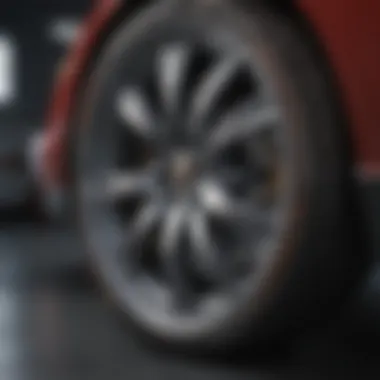Essential Rims Guide for Small Cars: Performance & Design


Intro
Choosing the right rims for small cars involves more than mere aesthetics. Rims serve crucial functions that impact numerous aspects, including handling, traction, and fuel efficiency. As consumer preferences evolve, understanding the nuanced roles rims play lets automotive enthusiasts, car owners, and prospective buyers make informed decisions. This guide explores various materials, designs, and technological advancements, ultimately emphasizing the balance between function and style.
Automotive Features and Innovations
Overview of Latest Technologies
In recent years, rim technology has advanced significantly. Manufacturers are now utilizing materials such as forged aluminum, which offer superior strength while reducing overall weight. These innovations lead to enhanced performance characteristics. Lightweight rims improve acceleration and reduce braking distances. They also play a role in fuel efficiency, as less energy is required to mobilize lighter materials.
The involvement of computational analysis in the design process contributes further to rim innovation. Advanced simulations in engineering ensure that every rim delivers peak performance and meets safety standards. Additionally, manufacturers are increasingly adopting methods that use recycled materials, addressing environmental concerns while still providing quality products.
In-Depth Look at Electric and Hybrid Vehicles
Small cars designed for electric and hybrid applications also necessitate specialized rims. Since electric and hybrid vehicles are generally heavier due to battery systems, rims must compensate through higher strength without excessive weight. Designs often include a focus on air circulation to enhance brake cooling. This factor is particularly important in performance electric vehicles that demand constant endurance.
Analysis of Autonomous Driving Systems
The emergence of autonomous driving systems will likely influence rim design and materials. Smart sensors integrated within rims could help monitor performance metrics like wear and tear or temperature, alerting drivers or systems in real time.
Evaluation of AI in Automotive Solutions
Artificial Intelligence continues to revolutionize automotive solutions. Within the context of rim selection and usage, AI can help predict optimum performance scenarios based on driving patterns and conditions. As cars become increasingly connected, the strategic pairing of advanced rims with vehicle algorithms fosters a deeper level of engagement with vehicle performance.
Understanding innovations in rims offers insights for future automotive trends. This knowledge can significantly impact purchase decisions for both individuals and automotive businesses.
Trends in Automotive Industry
With ongoing shifts towards sustainability, the rims market is also evolving. Favoring lightweight materials that aid fuel efficiency contributes to the overarching trend of environmentally-conscious driving. Consumers are looking towards brands like Enkei and BBS that strive to balance design with practicality. The automotive industry's future trajectory seems territories toward integrating technology into avenues such as rim design and manufacturing processes.
Electric Vehicle Adoption Rates
Adoption rates for personal electric vehicles are on the rise globally. As the number of electric vehicles increases, the demand for tailored rims that cater to unique characteristics of these vehicles will likely escalate.
Growth of Ride-Sharing and Mobility Solutions
Urban mobility solutions continue to shape the design landscape. Cars that serve multiple users have varying requirements, which will entice rim manufacturers to cater designs that enhance comfort mileages too.
Consumer Preferences Shifts and Impacts
An increase in interest toward custom rims for aesthetic appeal reflects a wider trend among consumers seeking to personalize their vehicles. Retail outlets must adapt to these trends, presenting scoopes of styling and performance options, clearly communicating their advantages to informed buyers.
Educational Resources
Technical Knowledge Base
The community supporting automotive education is burgeoning. Technical schools allude to rim technology during coursework, giving students pivotal knowledge to embark in their careers. Her, significant attention be placed in understanding local impacts made by small and big auto makers through innovative rims and supplies.
Insights Into Automotive Engineering
Experts disseminate understanding through integrated engineering curriculum that prepares future innovators in rim design and replaces tired models.
Certifications and Training Programs
An array of certification programs emphasizing emerging technological advancements provides insight into sustainable solutions. Fields such as automotive engineering degrees are paving ways for innovators focused on circular economies.
Future Trends in Automotive Education
In an ever-changing landscape, staying informed on current and upcoming trends in automotive education remains vital. Following market shifts ensures individuals and firms maintain pace with innovations, further solidifying their niche in a competitive segment. Ultimately, partnerships among educational and automotive sectors help prepare the workforce for future challenges.
Understanding these intertwined aspects enhances readers' comprehension thus guiding them through essential decisions seamlessly ranging from efficacies in rim choices to underlying shifting markets awaiting their selection in vehicles.
Understanding Rims and Their Importance
Rims play a crucial role in the performance, safety, and aesthetics of a vehicle. Their importance cannot be understated, especially for small cars, which often face specific challenges in maneuverability and efficiency. Choosing the correct rims will not only enhance the look of the car but also influenсe its dynamics. This section will delve into key components essential for appreciating rim selection’s implications.


Defining Rims
Rims are the circular metal or composite structures that connect the tires to the vehicle. They are integral parts of the wheel assembly and provide a surface for the tire bead to sit securely. Rims are typically made from materials such as aluminum, steel, or composite blends, each contributing different qualities to the overall performance of the vehicle. The properties of rims are often directly linked to the wheel's size and design.
Considerations around rim specifications include diameter, width, offset, and bolt pattern. Getting these measurements right is critical because any deviation might affect not just the fitment but the entire handling of the car. Proper fitting ensures that drivability remains smooth under various conditions.
The Role of Rims in Vehicle Performance
Rims serve several significant functions that directly affect vehicle performance, especially in small cars. The choice of materials can impact weight, strength, and heat dissipation. Light-weight rims made of aluminum, for example, can enhance acceleration and responsiveness.
Additionally, rims contribute to the overall aerodynamics of a vehicle. A design that reduces drag can lead to improved fuel economy, an essential aspect for small car owners concerned about efficiency.
Proper rim selection enhances not merely aesthetics, but the function and performance of the vehicle as well.
Braking performance also links closely to rim type. Wider rims often provide better performance with larger brake calipers while improving stability in daily driving contexts.
In summary, understanding rims and their importance lays a foundation for small car owners, automotive enthusiasts, and industry professionals alike. By delving into specifications and performance advantages, we prepare to explore the intricate ecosystem that is comprised of small car rims.
Characteristics of Small Car Rims
Understanding the characteristics of rims specifically designed for small cars is essential. This section addresses vital aspects that affect not just the aesthetics but the overall performance of vehicles in this category. Thus, consumers should consider various elements as they seek to optimize their automotive experience.
Size Considerations
Choosing the correct rim size for small cars directly influences handling and performance. A proper fit ensures that the vehicle maintains stability during turns and at higher speeds. If the rim is too wide or too narrow, it may lead to issues with alignment, steering, and even safety. The ideal diameter and width depend on multiple factors, including tire size and manufacturer recommendations. Understanding these specifications prevents potential mechanical problems or performance degradation, providing a safer driving experience.
Weight Efficiency
Weight plays a critical role in the performance of small cars. Lightweight rims improve acceleration and brake responsiveness, hence making handling easier. When rims are heavy, they contribute to unsprung weight, which may worsen the suspension performance. Small cars benefit significantly from lighter materials that reduce weight without sacrificing strength. This efficiency especially suits city driving, where quick accelerations and slowdowns are common. Automotive enthusiasts recognize that achieving an optimal balance between weight and design leads to superior performance over time.
Material Types
Rims come in various material types, each with distinct advantages and disadvantages. Selecting the right material can vastly impact your driving experience. Here we will examine three primary types used in small car rims:
Aluminum Rims
Aluminum rims are valued for their lightweight quality. This feature contributes to improved fuel efficiency and enhanced performance. They also offer better corrosion resistance compared to steel, which is particularly useful for cars that operate in wets or salty conditions. While aluminum rims may be pricier than other options, their visual appeal and modern designs make them____ a top choice for many drivers.
Steel Rims
Steel rims typically offer better durability and are often more affordable. They withstand impacts better and are less prone to bending, making them suitable for rough terrain or poorer road conditions. However, their heavier weight can impact performance negatively, chiefly on fuel efficiency and acceleration capabilities. Steel rims might not always provide the design flexibility that aluminum offers, potentially limiting a car owner's aesthetic options.
Composite Materials
Composite materials present a modern alternative that adds unique benefits. These rims boast the combined advantages of strength and flexibility. Using advanced technology in their production permits designs that are both light and capable of withstanding substantial stress. However, composites may not yet be as well established in the automotive aftermarket, which can limit consumer choice and availability. Generally, they offer cutting-edge findings when it comes to performance and design to suit diverse driving needs.
Investing the proper amount of research in each of these factors will enhance your experience with small cars significantly. Choose wisely, as it makes an identifying difference in comfort and safety.
In summary, selecting the right rim involves understanding the key characteristics pertinent to small cars. Size considerations, weight efficiency, and material types collectively shape the capabilities and aesthetics of the vehicle.
Design Options for Small Car Rims
Design options for small car rims play a significant role in both the functionality and aesthetic appeal of the vehicle. The selection must align with the vehicle's overall characteristics to enhance performance as well as provide visual satisfaction. Considerations include design aesthetics, aerodynamics, weight, and performance traits. As rims contribute to how a car handles on the road, making an educated choice regarding design options significantly impacts driving experience and safety.
Popular Rim Designs
Sleek Designs
Sleek designs are noted for their streamlined appearance and minimalist characteristics. These designs typically lack excessive protrusions or embellishments, which contribute to reduced aerodynamic drag. Sleek rims offer reduced weight, positively influencing fuel efficiency and enhancing acceleration capabilities. Their modern aesthetic appeals to those looking for sophistication while maintaining a practical advantage in terms of performance.
Key characteristics: Simplistic lines and smooth surfaces create an energetic feeling of speed, making them a beneficial choice when aesthetics abroad the small car are a priority.
In terms of ecology and functionality, these designs can also help extend the life of tires. However, due to their delicate nature, they may be less resilient against heavy impacts or rough terrain.
Aggressive Looks
Aggressive looks in rim designs are often appreciated by those who want to make a bold statement. These rims often feature deeper offsets and more pronounced designs that convey strength and performance. They can create an enhanced visual footprint on the road and destinguish small cars in a crowd.


Key characteristic: Bold lines which, when coupled with low-profile tires, mean better grip and handling during cornering because of additional rubber in contact with the road. Choosing aggressive looks can align well with vehicles designed for performance and style.
However, one should be cautious about the weight and size of this design. Excess weight can lead to fatigue during extended use and potentially impact gas millage when considering vehicle performance in its entirety.
Classic Styles
Classic styles draw inspiration from earlier automotive designs and blend in time-honored aesthetics. They often exhibit symmetrical patterns and a polished finish that recalls traditional designs. Their enduring visual appeal allows them to maintain popularity in the automotive market across different eras.
Key characteristic: Versatile compatibility makes them a favorite among small car owners seeking something timeless. Classic styles can pair well with different vehicle paint colors also achieving a broader market reach.
Regardless of their aesthetic utility, classic styles may sacrifice some aerodynamic performance compared to their modern counterparts. However, their widespread appeal often meets a preference for dignified and tasteful presentations.
Coating and Finishing
Coatings and finishes of rims contribute to both their durability and aesthetics. They impact corrosion resistance, longevity, and overall visual appeal of the rims. Choosing the right finish can mean a substantial difference in protecting against exposure from elements while enhancing style.
Paint Finishes
Paint finishes offer diverse color options, allowing car owners to customize their rims to match their overall vehicle theme. Their application leads to enhanced visual characteristics.
Key characteristic: Although paint finishes tend to involve less weight compared to other finishes, they can present issues with chipping and scratching under intense use or adverse conditions. Adequate maintenance might be required.
Chrome Plating
Chrome plating provides a shine unmatched by other materials. This finishing option enhances the rim's aesthetic through increased reflectivity and provides additional protection against rust and corrosion.
Key characteristic: It is compatible well with various car styles, beautiful appeal creating a glamorous finish. However, chrome plating might require specialized cleaning products to maintain that shiny surface as it is prone to fingerprints and smudges that mar visual appeal over time.
Powder Coating
Powder coating technology offers a durable finish through an applied dry paint method, ensuring an even and robust layer that stands up against impact, chipping, and fading. This type of finish is increasingly popular for automotive applications due its resilience against other elements in comparison.
Key characteristic: Its classification includes a wide range of color selections allows user to have options in presentation appearance. Consider the slight tradeoff; while powder coatings provide excellent protection, once applied, customization or removal can be challenging.
Selecting the Right Rims for Small Cars
Choosing the most suitable rims for small cars carries essential implications for performance, safety, and aesthetics. Proper rim selection can dramatically affect handling, steering response, and even fuel economy. It is critical for car owners, enthusiasts, and those considering a new purchase to grasp the factors that impact this decision. Evaluating rim compatibility with tires, offset and backspacing, and bolt patterns are crucial steps in facilitating an optimal fit.
Compatibility with Tires
One of the foundational aspects when selecting rims is ensuring compatibility with tires. Mismatched tires and rims can lead to suboptimal driving conditions and safety hazards. It is important to refer to tire specifications as well as guidelines listed in the vehicle’s manual. Often, tire size directly correlates with the rim's width and diameter.
Several key factors to consider include:
- Tire Width: The rim width supports the tire properly. A permissible range exists for tire width in relation to rim width. Deviations can affect performance.
- Aspect Ratio: Higher aspect ratios may work better with specific rims, impacting ride quality and performance.
- Diameter: Ensuring that the rim diameter matches the tire's specifications is non-negotiable for proper fitment.
- Load Capacity: Each rim and tire combination possesses a load-bearing capacity essential for safety and performance.
Normally, car manuals offer specifications regarding tire and rim combinations, minimizing guesswork.
Offset and Backspacing Considerations
Offset refers to how the rim aligns relative to the vehicle's hub mounting surface. Variations in offset influence handling and stability. In general terms, offsets can be divided into three categories:
- Positive Offset: When the hub mounting surface is closer to the front of the wheel, enhancing stability and reducing the chance of rubbing.
- Zero Offset: When it's in line with the centerline of the wheel, catering often to performance vehicles for center-weighted balance.
- Negative Offset: When the hub is closer to the back, which can lead to a wider stance but may cause interference with suspension or fenders.
Backspacing, on the other hand, is the distance from the rear of the rim to the mounting surface. Proper alignment between offset and backspacing helps in avoiding interference issues. Before making rim choices, measure existing backspacing. An incorrect combination could cause problems with steering, suspension wear, or even lead to damage.
Understanding Bolt Patterns
Bolt patterns are vital for ensuring rims fit securely onto the vehicle. Misalignment could yield potentially dangerous driving conditions. When assessing bolt patterns, be informed of the following details:
- Number of Bolt Holes: Most cars use four or five, although six is also common for larger or performance vehicles.
- Spacing: This is typically measured in millimeters. For example, a bolt pattern of 5x114 indicates there are five bolt holes, and they are spaced 114 mm apart.
- Circle Diameter: This aspect clarifies how far apart the bolts are situated. It requires precise measurement for accurate fitting.
Important Consideration
Proper rim selection cannot be overemphasized. It effectuates vehicle safety, responsiveness, and overall enjoyment.


Regardless of existing setups, confirming bolt patterns against desired rim models is essential. Failing to do so can end poorly, including stripped bolt holes or, in extreme circumstances, accidents.
Impact of Rim Selection on Performance
The selection of rims plays a crucial role in the overall performance of small cars. Rims, although often seen as mere aesthetic add-ons, significantly affect various aspects such as acceleration, handling, fuel efficiency, and braking performance. Understanding these factors can help car enthusiasts and potential buyers make informed decisions, aligning their rim choices with desired performance outcomes.
Acceleration and Handling
The relationship between rim selection and acceleration is noteworthy. Lighter rims contribute to reduced overall vehicle weight. This reduction improves acceleration without placing unnecessary strain on the engine.
On the other hand, the width of the rim can affect handling. A wider rim often offers better tire traction, which improves cornering capabilities. This enhanced stability is particularly beneficial during sharp turns or when navigating uneven surfaces.
Tire profile also ties into this issue. Looming larger tires may boost grip, though they can affect ride comfort and handling precision. Thus, achieving balance is essential. Mini Gulf’s line of rims exemplifies a furious blend of light weight and smart design.
Fuel Efficiency Considerations
Rim selection directly influences fuel efficiency. When rims are lighter, less energy is required for the car to move, translating into fewer fuel consumption. Choosing a suitable rim material like aluminum instead of heavier steel can yield better fuel economy.
A wider surface can also improve aerodynamics. Aerodynamic styling in rim design can reduce drag while driving. That small stop should be carefully balanced against comfort and drivability, depending on one’s personal driving style.
Maintaining Rims for Longevity
Maintaining rims for longevity is crucial not only for appearance, but also for the overall performance of small cars. Rims can undergo a lot of stress from driving and weather conditions, leading to wear and potential damage. Proper maintenance can significantly extend the lifespan of the rims, preserving both the aesthetic and functional quality. Here, we will explore the key components involved in maintaining rims, yielding clear benefits for any vehicle owner.
Cleaning Techniques
Clean rims are essential for both the looks and performance of a vehicle. Dirt, brake dust, and road grime can accumulate quickly and cause corrosion or permanent stains. To clean rims effectively, consider the following methods:
- Use a dedicated wheel cleaner designed for the specific material of your rims, whether aluminum or steel.
- Avoid harsh chemicals that can strip the finish or damage the surface. Soap and water can often be adequate.
- Apply a soft-bristle brush to scrub the surfaces, preventing scratches.
- Rinse thoroughly before drying with a soft microfiber towel to avoid water spots.
Regular cleaning not only enhances visibility but also helps prevent long-term damage, making periodic checks essential.
Inspecting for Damage
Regular inspection for damage is essential in ensuring that rims remain in good condition. Small cracks, bends, or visual blemishes can signal a need for repair or replacement. Here are some critical points to check during an inspection:
- Examine the rims for visible scratches or gouges, which can indicate contact with curbs or other road hazards.
- Determine if there are any dents or bends; even minor damage can lead to performance issues.
- Look for severe stains from brake dust, which can eat away at the rim finish if left untreated.
A good practice is to inspect rims regularly, at least once a month, and right after hitting a pothole or curb. Ensuring structural integrity is important for optimal driving performance.
Preventing Corrosion
Preventing corrosion is a significant aspect of rim maintenance, especially for those living in areas with harsh weather or where salt is used for road treatment. Corrosion not only impacts the rims visually but can also affect safety and longevity. To prevent corrosion, consider these strategies:
- Apply protective coatings such as wax or sealants suitable for the rim material, which will protect against moisture and dirt buildup.
- Store rims properly in a cool, dry location when not in use. Avoid exposing them to harsh conditions.
- Ensure wheels are dry before re-installing after a wash or exposure to rain, as trapped moisture can accelerate corrosion.
Taking these preventive measures is vital to sustaining the quality of your rims over time. By being diligent in maintenance, car owners ensure rims not only last longer, but confidently enhance performance throughout their vehicle experience.
Proper care and regular maintenance can yield significant benefits diametrically opposed to neglecting rims, underscoring the wisdom of preventative measures in automotive care.
Future Trends in Rim Technology
The world of automotive rim design is evolving rapidly. Innovations are reshaping how we think about rims, especially for small cars. Understanding these future trends is essential for enthusiasts and consumers who seek both aesthetics and performance. New materials are enhancing durability, while technological integration is ensuring better performance. This section will cover critical developments in rim technology that can influence buying decisions and vehicle performance.
Innovations in Materials
Recent advancements in materials for rims include lightweight composites and advanced aluminum alloys. The pursuit of increased fuel efficiency influences these developments. Lighter rims can substantially reduce the overall weight of a vehicle, leading to improved gas mileage and better acceleration.
Additionally, modern coatings and treatments improve resistance to scratches, corrosion, and other environmental damage. This longevity adds value to a vehicle, minimizing long-term maintenance costs. Various materials fulfill different needs, so selecting the right one is crucial. Enhanced resilience paths can lead to safer, more reliable driving experiences.
Integration of Technology
Smart Rims
Smart rims use sensors to monitor important aspects such as pressure and temperature. Their inner workings often incorporate technologies to track performance metrics. This observability is particularly valuable for performance-driven users who place importance on precision and efficiency. Furthermore, they can alert users about issues like tire under-inflation or excessive wear in real-time, potentially preventing accidents and improving safety. The practicality of having integrated smart capabilities places these rims in the limelight for modern small cars, making driving safer.
Monitoring Systems
Monitoring systems are another significant trend. They dynamically gather data about rim condition and performance while providing feedback to drivers. A primary characteristic is their ability to interface with mobile applications, offering real-time performance stats directly. Such tech-friendly accessibility promotes informed decision-making concerning maintenance or repairs.
Detailed information updates regarding wear can mean drivers can proactively replace parts before problems escalate. This proactive approach not only extends the life of both rims and tires, but it also ensures safety in driving.
As technology advances, rims will likely incorporate even more smart solutions, promising an exciting horizon for both car design and user experience.







